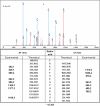Proteomic analysis of human aqueous humor using multidimensional protein identification technology
- PMID: 20019884
- PMCID: PMC2793904
Proteomic analysis of human aqueous humor using multidimensional protein identification technology
Abstract
Aqueous humor (AH) supports avascular tissues in the anterior segment of the eye, maintains intraocular pressure, and potentially influences the pathogenesis of ocular diseases. Nevertheless, the AH proteome is still poorly defined despite several previous efforts, which were hindered by interfering high abundance proteins, inadequate animal models, and limited proteomic technologies. To facilitate future investigations into AH function, the AH proteome was extensively characterized using an advanced proteomic approach. Samples from patients undergoing cataract surgery were pooled and depleted of interfering abundant proteins and thereby divided into two fractions: albumin-bound and albumin-depleted. Multidimensional Protein Identification Technology (MudPIT) was utilized for each fraction; this incorporates strong cation exchange chromatography to reduce sample complexity before reversed-phase liquid chromatography and tandem mass spectrometric analysis. Twelve proteins had multi-peptide, high confidence identifications in the albumin-bound fraction and 50 proteins had multi-peptide, high confidence identifications in the albumin-depleted fraction. Gene ontological analyses were performed to determine which cellular components and functions were enriched. Many proteins were previously identified in the AH and for several their potential role in the AH has been investigated; however, the majority of identified proteins were novel and only speculative roles can be suggested. The AH was abundant in anti-oxidant and immunoregulatory proteins as well as anti-angiogenic proteins, which may be involved in maintaining the avascular tissues. This is the first known report to extensively characterize and describe the human AH proteome and lays the foundation for future work regarding its function in homeostatic and pathologic states.
Figures


References
-
- Stastna M, Behrens A, Noguera G, Herretes S, McDonnell P, Van Eyk JE. Proteomics of the aqueous humor in healthy New Zealand rabbits. Proteomics. 2007;7:4358–75. - PubMed
-
- To CH, Kong CW, Chan CY, Shahidullah M, Do CW. The mechanism of aqueous humour formation. Clin Exp Optom. 2002;85:335–49. - PubMed
-
- Kramer M, Goldenberg-Cohen N, Axer-Siegel R, Weinberger D, Cohen Y, Monselise Y. Inflammatory reaction in acute retinal artery occlusion: cytokine levels in aqueous humor and serum. Ocul Immunol Inflamm. 2005;13:305–10. - PubMed
-
- Apte RS, Niederkorn JY. Isolation and characterization of a unique natural killer cell inhibitory factor present in the anterior chamber of the eye. J Immunol. 1996;156:2667–73. - PubMed
-
- Rohde E, Tomlinson AJ, Johnson DH, Naylor S. Comparison of protein mixtures in aqueous humor by membrane preconcentration - capillary electrophoresis - mass spectrometry. Electrophoresis. 1998;19:2361–70. - PubMed
Publication types
MeSH terms
Substances
Grants and funding
LinkOut - more resources
Full Text Sources
